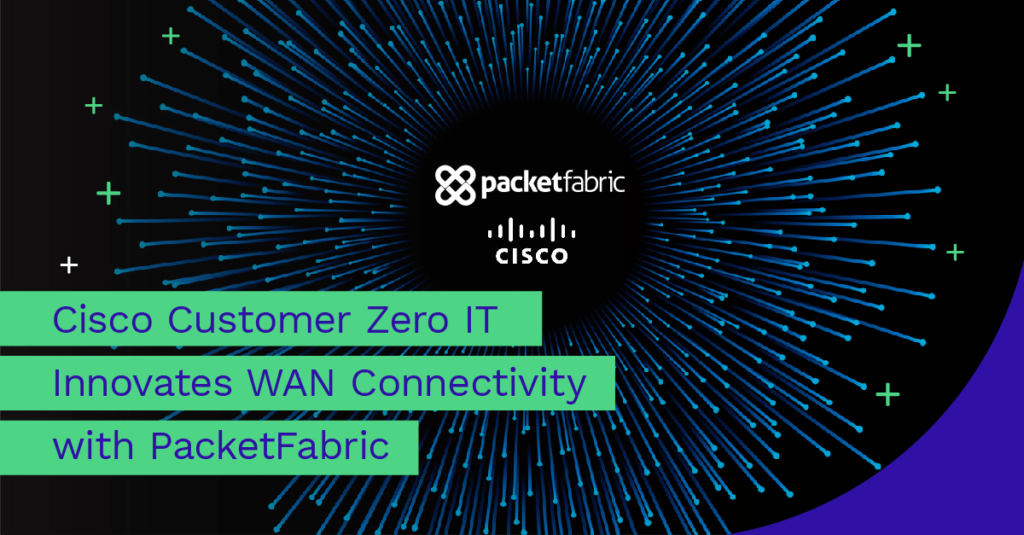Customer Zero Engineering is a team of IT professionals within Cisco that leans forward into new technologies that can change the way people manage connected experiences.
Led by Jon Heaton, the Customer Zero team has (among many other things) been working to take Cisco on a journey to an advanced network architecture. We are pleased to share that PacketFabric is part of this journey of innovation with Cisco IT.
Powerful Motivations for a Software-defined Network Approach
Corporate networks are evolving fast, and demands on Cisco’s network have grown exponentially. Network teams need more agile and automated ways of managing networks. The motivations include gaining speed to meet end user information technology demands, while maintaining the quality to deliver great customer experiences along with sound cybersecurity.

Travis Norling details more about these motivations and how they play out in campus access networks in his blog on the journey to a software-defined access fabric network. He covers moving away from CLI-based interactions with routers’ operating systems and manually configuring ACLs, towards intent-based automation that can encompass secure segmentation models. These capabilities are helping Cisco IT plan a safe return to Cisco campuses in San Jose and beyond. They also reduce configuration errors, and prevent needless helpdesk calls and wasteful troubleshooting.
As the Landscape Evolves, so Must the Enterprise Backbone
But the access network isn’t the only place where transformation is needed. Roel Bernaerts shares in this blog how within the Cisco network, technologies such as cloud, bring your own device (BYOD), and the Internet of Things (IoT) are causing huge shifts in traffic patterns, and requiring new ways of thinking about network security. Some traffic that used to stay strictly internal is routing over the internet. Hybrid and multi-cloud traffic has grown, and data mobility needs mean that there are often large-scale transfers between data centers. To adapt to these new and ever-changing needs is leading Cisco to move from an enterprise-like backbone to a service-provider-like backbone. What will that look like? Ultimately, the goal is agility: to enable the network to respond to user needs within minutes.
Barrier: Traditional Backbone Connectivity Models
Traditional telecom connectivity services offer great privacy, security and predictable performance (read: SLAs). However, they come with some significant barriers to the kind of agility required by networks that experience a high pace of change. First of all, it can take quite a long time to provision circuits. But more importantly, it is hard to change them because you have to lock in long-term. Furthermore, you have to commit to a point-to-point connection that can’t really change, at whatever is your anticipated peak bandwidth requirement, even if you know you’ll only use a fraction of that on average. But fortunately, there is a better answer.
On-demand, Telco-scale Connectivity
PacketFabric offers telco-scale, private, secure connectivity for data center interconnect, hybrid cloud, and multi-cloud use cases. You get all the predictable performance and high quality SLAs you could wish for, because our network-as-a-service (NaaS) platform was built for scale from the beginning, with multi-100G at every PoP, dual stacks and redundant paths.
The difference is that you can turn on this connectivity in minutes via an easy to use web portal, consume it as you wish (month-to-month or longer terms), and manage bandwidth allocation flexibly and programmatically. Practically speaking, it means you can use a single port on our network to reach any of hundreds of data centers, cloud providers, and even SaaS and VoIP/UCaaS offerings, like Webex Edge Connect.
The strategic transition from traditional WAN consumption to a programmatic consumption model that enables rapid growth (or contraction) and interconnection helps our customers control OPEX. PacketFabric NaaS services can bolster existing services, complement branch SD-WANs, and enable a future workforce with a more secure, private mid-mile and cloud connectivity. Gaining a flexible backbone is part of the modernization of IT infrastructure accelerated by the COVID-19 pandemic.
Heaton commented, “Consuming WAN connectivity via PacketFabric helps Cisco IT drive innovation in the service of Cisco’s business.”
Learn More
Cisco IT is on a network transformation journey that sets the standard for enterprises. You may be learning about their advanced network architecture because you’re on a Cisco certification journey (CCNA, CCIE, CCENT, CCNP). You can read about what’s going on Inside Cisco IT on at https://blogs.cisco.com/ciscoit.
But you may already be on your own WAN transformation journey. If you want to learn how you can get access to high speed multi-cloud connectivity with zero hardware, physical ports or any infrastructure, check out our Virtual Cloud Router. If you have hybrid cloud connectivity needs between data centers, or to cloud on-ramps, check out our on-demand Point-to-Point Networking and Hybrid Cloud Connectivity services. And if you’re looking for the best way to get high-speed, secure connectivity to Webex, check out our Webex Edge Connect page.